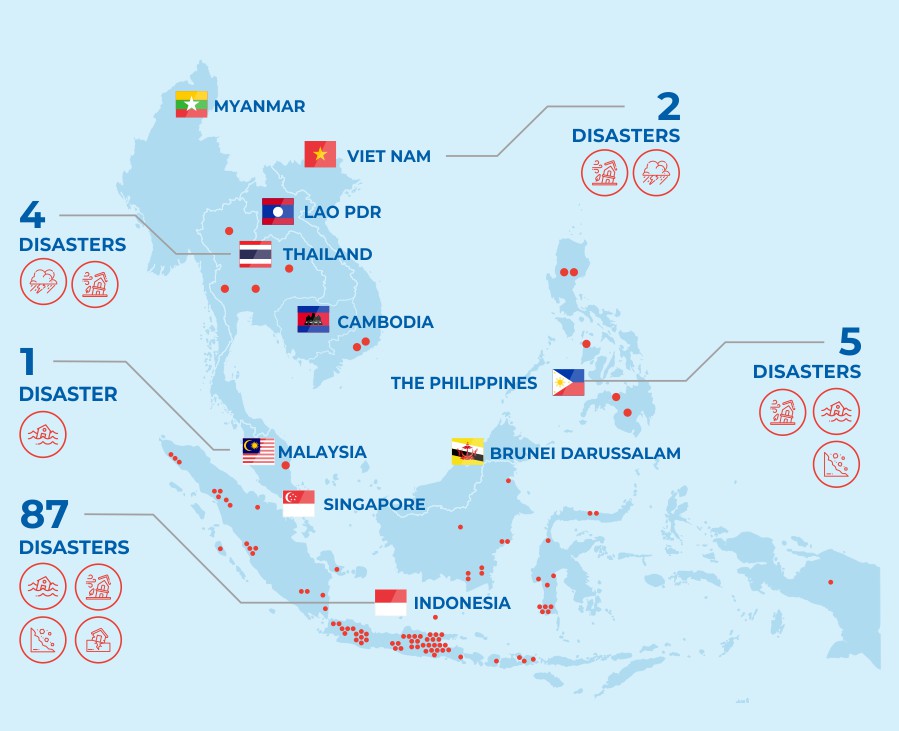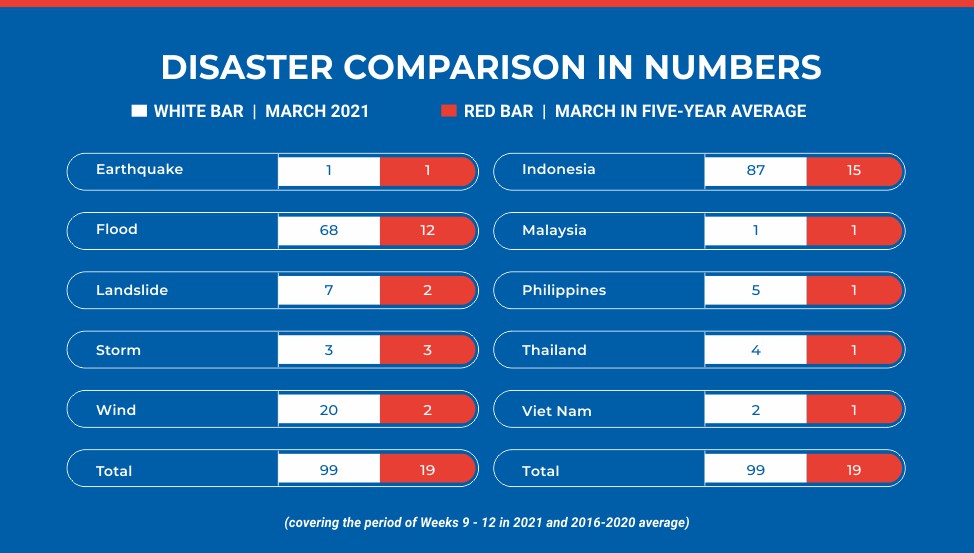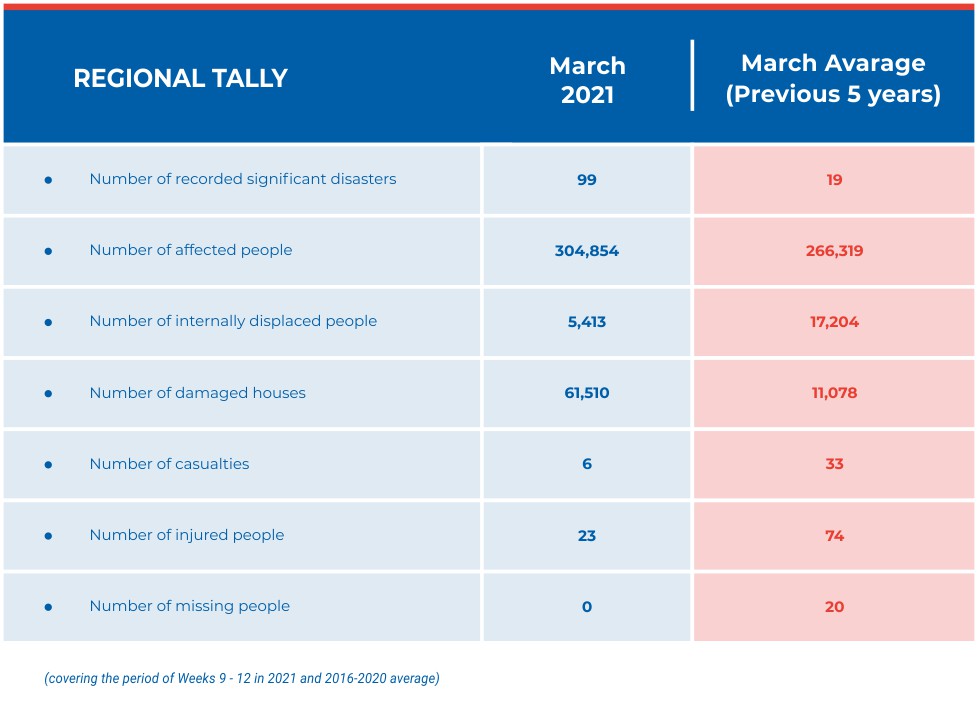
MONTHLY DISASTER REVIEW AND OUTLOOK
MARCH 2021 | DISASTER MONITORING & ANALYSIS
(DMA) UNIT, AHA CENTRE
GENERAL REVIEW OF MARCH 2021
March 2021 saw a five-fold increase in terms of number of disaster occurrences compared to the five-year average for the same month. Noticeably, the number of houses that have been damaged/affected by reported disasters (63% of which were floods) for the period was also more than 5 times higher than the average. There is also an increase in the number of affected people during the month of March 2021. In contrast, lower numbers were observed for internally displaced persons (68.5% decrease), casualties (81.8% decrease), injuries (68.9% decrease), and missing people (100% decrease). The increase in disaster numbers were largely driven by the La Niña conditions resulting in increased precipitation across Indonesia – from where almost 80% of the disasters were reported. As of the first quarter of 2021, the number of disaster reports (328) is already more than half of the previous year’s annual total (530). Despite this significant increase, the number of affected people for 2021 is on-track to come in well below 2020’s totals, with current figures reaching 14% of 2020’s final amount (26.1 million).
A total of 19 significant earthquakes (M≥5.0) were reported in the region for March 2021 by local authorities in Indonesia and the Philippines. Volcanic activity was also reported for volcanoes currently on Alert Level III, namely Mount Merapi and Sinabung in Indonesia. Taal Volcano in the Philippines was elevated to Alert Level 2 with steam-driven or phreatic eruptions, volcanic earthquakes, ash, and a dangerous accumulation/emission of volcanic gas affected surrounding areas. Activity was also reported for the mountains of Ibu, Dukono, Raung, and Kerinci in Indonesia, and also Mayon and Pinatubo in the Philippines – but none resulted in significant damage. Such early warning information from the local agencies is crucial in mitigating the effects of tectonic hazards.
SEASONAL OUTLOOK
The ASEAN Specialised Meteorological Centre (ASMC) sees a likely transition in the ASEAN region from Northeast Monsoon to inter-monsoon conditions in April 2021, and prevailing winds are expected to be light and variable in direction on most days. An increase in shower activities is expected as the monsoon rain band moves over the equator. The inter-monsoon conditions are expected to persist until May 2021, before a transition to Southwest Monsoon conditions in June 2021.
For the April to June 2021 period, models predict above-average rainfall over much of the ASEAN region north of the equator (mainland Southeast Asia and central and northern Philippines), and some chance of below-average rainfall for much of Sumatra and Borneo. La Niña conditions are present over the tropical Pacific Ocean, with climate models predicting its continued weakening to ENSO neutral conditions throughout the months of April to June.
Warmer-than-usual temperatures are expected over the equatorial region Peninsular Malaysia, Indonesia, as well as southern Philippines. The traditional dry season for the Mekong sub-region is likely to continue into April and May 2021, with significant hotspot and smoke haze activities. Above-average rainfall is expected for the sub-region, and shower activities on some days could help to alleviate the situation. The traditional dry season for the Mekong sub-region is expected to end by late May/early June 2021. Some parts of the southern ASEAN region, such as Sumatra and Borneo, may experience below-average rainfall between April-June 2021, and isolated hotspots with localised smoke plumes may develop at times during periods of drier weather. More persistent dry weather for the southern ASEAN region is expected from June 2021 as the traditional dry season sets in, increasing the risk of elevated hotspot activities and transboundary smoke haze.
The qualitative outlook is assessed for the region in general and based on the latest runs from models provided by the SEA RCC-Network LRF node. For specific updates on the national scale, the relevant ASEAN Member States National Meteorological and Hydrological Services should be consulted.
Sources : ASEAN Disaster Information Network (ADINet), ASEAN Specialised Meteorological Centre (ASMC), ASEAN Disaster Monitoring and Response System (DMRS), Badan Nasional Penanggulangan Bencana (BNPB), Pusat Vulkanologi dan Mitigasi Bencana Geologi (PVMBG), Badan Meteorologi, Klimatologi dan Geofisika (BMKG), National Disaster Risk Reduction and Management Council (NDRRMC), Philippine Institute for Volcanology and Seismology (PHIVOLCS), National Disaster Management Agency – Malaysia (NADMA), Department of Disaster Prevention and Mitigation – Thailand (DDPM), Viet Nam Disaster Management Authority (VNDMA)
Written by : Keith Paolo Landicho, Sadhu Zukhruf Janottama, Lawrence Anthony Dimailig
DISCLAIMER
Disclaimer from ASMC: The qualitative outlook is assessed for the region in general and based on the latest runs from models provided by the SEA RCC-Network LRF node. For specific updates on the national scale, the relevant ASEAN Member States’ National Meteorological and Hydrological Services should be consulted.



